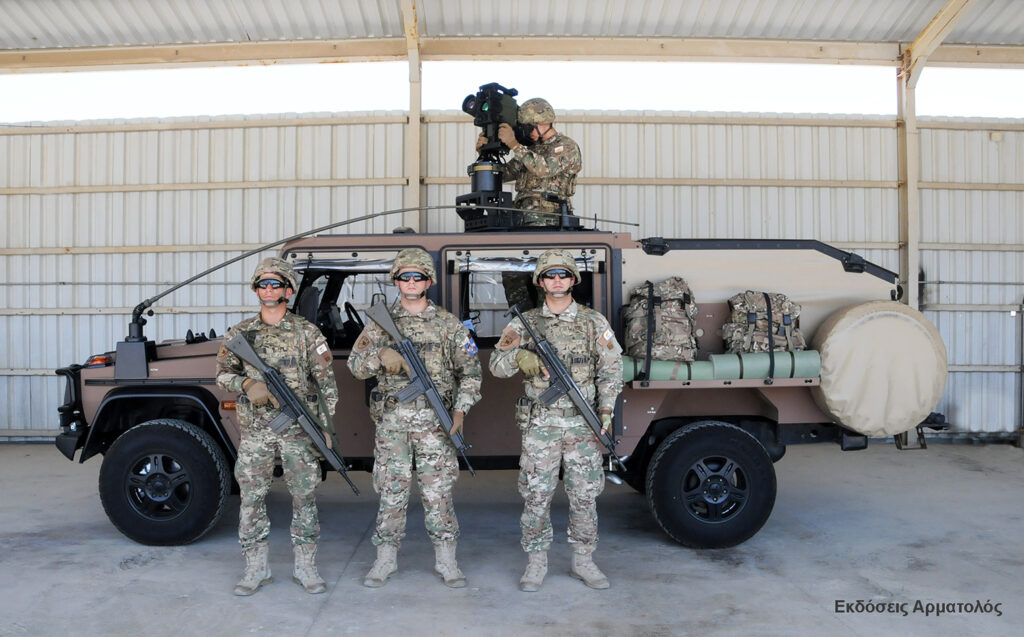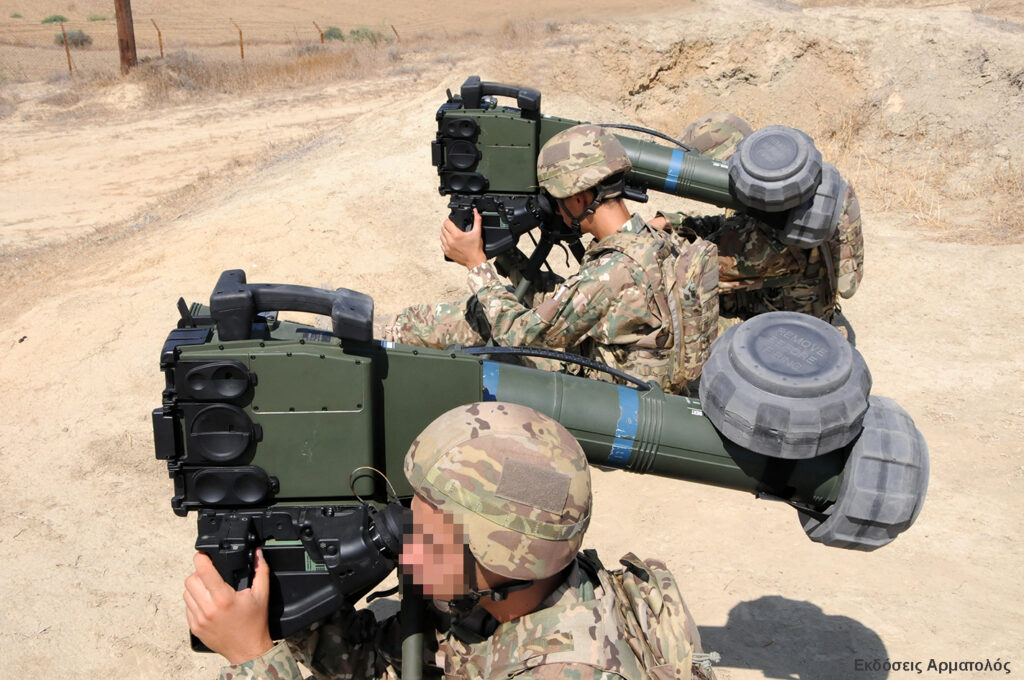Filenews 26 October 2025 - by Petros Savvides
The inclusion in the arsenal of the National Guard of the state-of-the-art, Israeli, 5th generation SPIKE LR2 missiles of the German Eurospike consortium gave the force unprecedented anti-tank capabilities, since the use of state-of-the-art technologies allows the attack of tanks and armoured vehicles with absolute accuracy at a range of 5.5 kilometers, day and night. The acquisition of BLOS (Beyond Line of Sight) capability, i.e. to attack enemy targets beyond the visual horizon, is made possible by the ability of the systems to receive data on targets that are not visible to the shooter, from drones (FPVs) that can exploit the system, advanced artillery observers, or through other systems. Rafael Advanced Defense Systems' SPIKE LR2 system is used by 45 countries, 19 of which are members of the European Union/NATO.
The system consists of three main parts, with the iCLU (Integrated Command Lunch Unit) launcher, weighing 10.4 kg, being the heart of the system, i.e. the means of observing, detecting and attacking the target. The observation of the field and the location of the target is done by high-quality electroptic and thermal sensors, and the determination of its position by an electronic compass, a GPS positioning antenna and a laser rangefinder. The launcher is connected by cable to a portable tablet (SUDOCU) operated by the element leader, who has the ability to monitor the shot and intervene if required.

The missile, weighing 14 kg, is essentially a smart and versatile ammunition of high destructiveness, which incorporates its own electro-optical and thermal sensor, while its powerful double explosive warhead (tandem HEAT) can penetrate any tank, even those with active armour or any other passive protection. The missile does not interfere since it is connected to the launcher by fiber optics. It has two engines, the propulsion engine and the main engine, and the speed of the missile ranges from 130 to 180 meters per second (depending on the type of trajectory) while the target attack time at maximum range is 55 seconds.
The tripod of the system provides great tactical flexibility, since, in addition to firing from the specialized vehicle, it is possible to use the launcher from the ground. Firing shots on the tripod significantly reduces the ability to observe the enemy and identify the firing point, thus increasing the survivability of the element on the battlefield.

The system incorporates cutting-edge technologies, providing great flexibility to the operator. In addition to the ability to automatically merge data from the launcher and missile sensors, which gives destructive accuracy during attacks, the system provides the ability to perform three types of shots:
* Fire and Forget, i.e. entrapment of the target and its automated attack, increasing the survivability and firing rate of the system, and
* Fire and Observe, entrapment of the target and control of the shot, by the operator or the commander of a unit, with the possibility of intervening until it is attacked
* and Fire to Target Coordinates (Fire to Grid), i.e. attacking the target that is not visible to the shooter, by means of data obtained from other sensors.
In addition, it is possible to preselect the trajectory of the rocket, offering different flight altitudes depending on weather conditions and tactical conditions. There is also the possibility of an almost vertical attack on the target (top down) and the impact of the missile on the tank tower, or the roof of the armoured vehicles, which are the most vulnerable points in terms of armour.

Due to the technological requirements for the training of personnel, the manufacturer has two types of shooting simulators. The ODT (field simulator) system is integrated into the operational launchers and provides the ability to perform virtual shots in the field against real targets on the move up to the maximum range of the missile The IDT system (room simulator) is installed indoors and offers the ability to fire in a virtual reality environment. The training is based on pre-designed scenarios of various difficulties for all types of shots, even for shots beyond the visual horizon, by obtaining data from independent sensors, such as drones or from advanced observers.
The acquisition of this system by the National Guard gives great operational capabilities to the Force, which far exceed the capabilities of the previous systems it had included in its arsenal over the last four decades, namely the Franco-German Milan system and the French HOT system, with a maximum range of two and four kilometers respectively. The multiple advantages of the SPIKE system do not only concern the increased range of the family of missiles used (LR2 five km, ER eight km, ER2 ten km), but the state-of-the-art technologies integrated into the system; not only in the launcher but also in the rocket itself which is extremely accurate and destructive while, at the same time, it becomes extremely difficult to interfere with or counter.
Undoubtedly, the inclusion of the National Guard in the SPIKE missile family is a correct and important decision. The adoption of asymmetric tactical and state-of-the-art weapon systems to counter the numerical superiority of the manoeuvring echelons of the Turkish occupation forces (300 tanks and about 700 armoured vehicles) offers critical advantages. The ongoing, catastrophic, war in Ukraine has demonstrated, in addition to the bloodbath of the modern battlefield, the deadlocks of symmetrical warfare (tank against tank) in conditions of decisive struggle to the end between the opponents, highlighting the value of rapid readjustment and the imaginative use of asymmetric tactics and means to deal with the enemy threat.
*Academician, geopolitics, defense and security analyst -Thanks to the Ministry of Defense and the NGNGS for granting the relevant permission and to the Unit for the kind hospitality.
